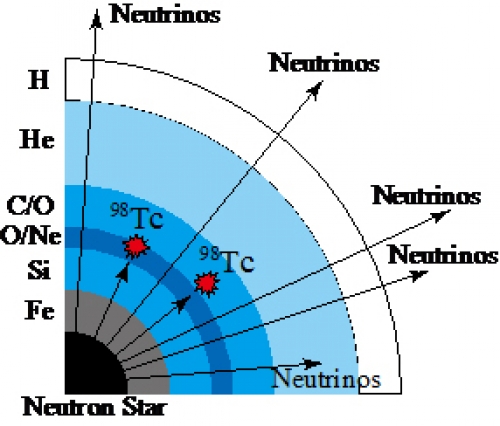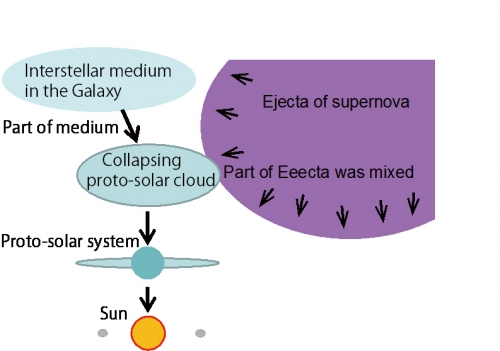研究成果 Research Results
- TOP
- News
- Research Results
- Technetium-98 nuclear cosmochronometer synthesized by supernova neutrinos
Technetium-98 nuclear cosmochronometer synthesized by supernova neutrinos
2018.09.12Research ResultsPhysics & Chemistry
A team of researchers has theoretically predicted that an unstable isotope Technetium-98 (98Tc) could be synthesized by neutrinos emitted from supernova explosions.
A large number of neutrinos are emitted from the proto-neutron star formed during an early phase of a core-collapse supernova. When these neutrinos pass through the outer layers, they partially deposit their energy in the outer layers, leading its supernova explosion. In the outer layers, some nuclides such as Tantalum-180 are newly synthesized by the neutrino-nucleus interaction. There are six neutrino species, electron neutrino, muon neutrino, tau neutrino, and their anti-neutrinos.
Previous studies have shown that the neutrino-isotopes are predominantly produced by five neutrino species except the electron anti-neutrino. If there was a neutrino-isotope synthesized predominantly by the electron anti-neutrino, one could estimate the temperature of the six neutrino species, which are important for understanding the supernova explosion mechanism.
At the present study, first, it was found the possibility that 98Tc may be synthesized by the neutrino process.
Next, the expected 98Tc abundance was calculated using a supernova explosion model with the neutrino-nucleus interactions involved.
As a result, it was found that 98Tc neutrino-process nucleosynthesis is the large contribution (∼20%) from charged current reactions with electron anti-neutrinos. It was shown that if the initial abundances of 98Tc were to be precisely measured, the 98Tc nuclear cosmochronometer could be used to evaluate the initial abundance of 98Tc and the duration time from the last core-collapse supernova to the formation of the solar system.
The present result is also important for the average temperatures of the six neutrinos and astronomical observation of the electron anti-neutrino.
This work will be published in Physical Review Letters.

Figure 1. Element production by neutrinos emitted on supernova explosion

Figure 2.
Substances formed in supernova are drawn together into the proto-solar system
Journal Reference
Short-Lived Radioisotope 98 Tc Synthesized by the Supernova Neutrino Process, ,Physical Review Letters, 10.1103/PhysRevLett.121.102701Research-related inquiries
- TOP
- News
- Research Results
- Technetium-98 nuclear cosmochronometer synthesized by supernova neutrinos































